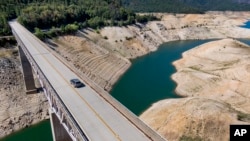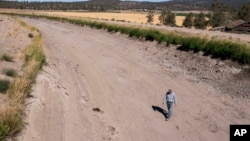Researchers say the severe drought affecting the American West worsened last year and is now the driest in at least 1,200 years.
The scientists report in a new study that 40 percent of the drought’s intensity is linked to human-caused climate change. The study recently appeared in Nature Climate Change.
The researchers found that 2021 was especially dry. The United States government’s Drought Monitor map shows that 55 percent of the American West is currently suffering drought conditions.
Over the past 10 years, California and other western states have experienced severe water shortages. This led to widespread usage restrictions and raised concerns about future water supplies for farming and drinking.
Overall levels of snow and rain have not been enough to make up for the shortages.
Park Williams is a climate specialist with the University of California, Los Angeles. He helped lead the study. Williams told The Associated Press that the current drought actually began in 2002, which was one of the driest years on record.
“I was wondering if we’d ever see a year like 2002 again in my life and in fact, we saw it 20 years later, within the same drought,” he said. The drought levels in 2002 and 2021 were very close. But the single driest year was 1580.
Scientists say climate change from the burning of fossil fuels has caused hotter temperatures and increased evaporation in the air.
In the study, Williams and his team tested soil for dryness in a series of U.S. states across the West and areas in northern Mexico. The researchers used modern measuring equipment and examined tree rings to make estimates dating back as far as the year 800.
A few years ago, Williams studied the current drought and said it met the requirements to be considered a long and deep “megadrought.” But he said 2019 turned out to be a wet year, so he thought the western drought might be coming to an end. But the American West then dried up in late 2020 and 2021.
Williams used 29 models to create a hypothetical world with no human-caused warming. Then, he compared that to what happened in real life. Such a comparison is a scientifically accepted method to identify whether an extreme weather event was caused by climate change.
Williams found that 42 of the drought conditions were directly linked to human-caused warming. Without climate change, he said, the megadrought would have ended earlier because 2005 and 2006 would have been wet enough to break it.
Jonathan Overpeck is with the School for Environment and Sustainability at the University of Michigan. He was not involved in the latest study. But he called it “an important wake-up call.”
“Climate change is literally baking the water supply and forests of the Southwest, and it could get a whole lot worse if we don’t halt climate change soon,” Overpeck said.
Williams said there is a direct link between drought and higher temperatures and the increase in wildfires that have affected the West for years. This is because the fires need dry fuel created by drought and heat.
Williams said the current megadrought can be ended with a few good rainy years. But, with continuing climate change, another extreme dry period could quickly start again, he added.
I’m Bryan Lynn.
The Associated Press and Agence France-Presse reported on this story. Bryan Lynn adapted the reports for VOA Learning English.
We want to hear from you. Write to us in the Comments section, and visit our Facebook page.
_____________________________________________________
Words in This Story
drought – n. a long period of time during which there is very little or no rain
fossil fuel – n. fuels such as coal, oil, or natural gas formed in the earth from dead plants or animals
evaporate – v. to turn from a liquid into a vapor
hypothetical – adj. a situation or idea that has been suggested but does not yet exist or has been proven to be true
literally – adv. with the meaning of each individual word given exactly











